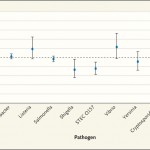Closure (?) on Salmonella Saintpaul
The New England Journal of Medicine has just published a CDC report bringing the Salmonella Saintpaul outbreak of 2008 to an apologetic close (for a quick rundown on the history of this incident, see my previous posts).
The investigation of this outbreak first implicated tomatoes, with devastating effects on the tomato industry. As the paper concludes:
Although an epidemiologic association with raw tomatoes was identified early in this investigation, subsequent epidemiologic and microbiologic evidence implicated jalapeño and serrano peppers. This outbreak highlights the importance of preventing raw-produce contamination.
Yes it does. Jalapeño and serrano peppers turn up in salsas and guacamoles. These are mixtures of many ingredients that are often eaten with chips or prepared foods. People have a hard time remembering whether they ate peppers or not, particularly when the peppers are chopped fine. As the investigators explained:
This outbreak investigation highlights the recurring challenges of epidemiologic identification of ingredients in foods that are commonly consumed, rapid identification and investigation of local clusters, the need to continue exploring hypotheses during an ongoing outbreak, and produce tracing in the supply chain.
Traceback issues such as commingling, repacking, varying degrees of product documentation throughout the supply chain, difficulty in linking incoming with outgoing shipments to the next level in the distribution chain, and the complexity of the distribution chain continue to hinder product-tracing efforts….
In addition, an understanding of the mechanisms and ecologies that can lead to contamination of produce on farms and the institution of additional control measures from the source throughout the supply chain are critical for preventing similar outbreaks in the future.
In other words, we badly need farm-to-table safety controls for all foods, no exceptions.
But, as the accompanying editorial by Michael Osterholm explains,
The new law has a major shortcoming: dollars. There was no appropriation approved by the Congress for the act or authorization in the bill for the FDA to assess fees on the companies that it inspects. The Congressional Budget Office estimated that implementing this legislation would require $1.4 billion between 2011 and 2015….
Recent reports in the media calling this act “historic legislation” must be tempered by the reality that without the necessary resources, requiring the FDA to carry out the law’s required activities will be like trying to get blood out of a rock.
Blood out of a rock? The House just passed a bill that would CUT the FDA’s food safety budget by $241 million.
Of course the FDA doesn’t need the funds. After all, only 21% of the 1,500 people known to have gotten sick with Salmonella Saintpaul had to be hospitalized, and only 2 died. And Salmonella Saintpaul is in foods that real Americans don’t eat anyway, like peppers with funny foreign names and alfalfa sprouts.
I used to say that Congress would never move on food safety until a close relative of a senior Senator became seriously ill with food poisoning. Now I have to include a senior House member.


